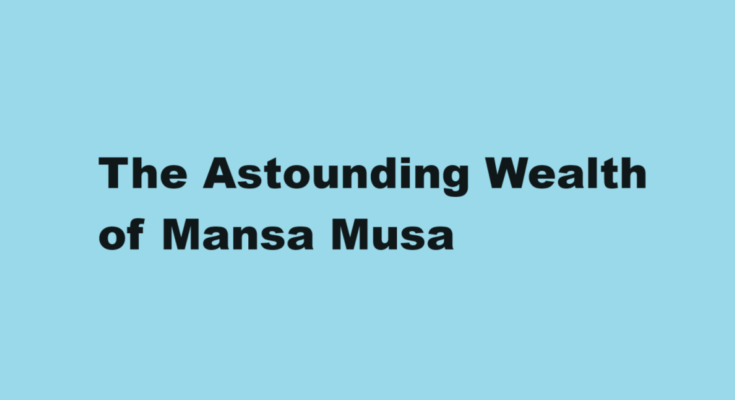Mansa Musa, the 14th-century emperor of the Mali Empire, is often cited as the wealthiest individual in history. His reign from 1312 to 1337 is marked by vast wealth accumulation, significant cultural and educational contributions, and extensive territorial expansion. Mansa Musa, also known as Musa I of Mali, inherited the throne in 1312 and ruled over the Mali Empire, which was one of the largest and wealthiest empires in the world at the time. His wealth was primarily derived from the extensive natural resources of his empire, including gold and salt. Musa’s extravagant pilgrimage to Mecca in 1324-1325 highlighted his immense wealth and left a lasting impact on the regions he passed through.
Historical Context – Mansa Musa
The Mali Empire – An Overview
The Mali Empire was one of the most influential and powerful empires in West Africa during the mediaeval period. It flourished from the 13th to the 16th century, becoming a centre of trade, culture, and wealth.
| fact | detail |
| founded | 1235 CE |
| Peak period | 14th century |
| capital | timbuktu |
| language | Manding languages |
| Major trade goods | Gold, salt, ivory |
Mansa Musa’s Rise to Power
Mansa Musa, also known as Musa I, ascended to the throne of the Mali Empire in 1312 CE. His rise is attributed to his strategic acumen and the empire’s rich resources.
| year | event | description |
| 1312 | Ascension to the throne | Mansa Musa became emperor following the death of his predecessor |
| 1315 | Military expansion | Expanded the empire’s territory through successful campaigns. |
| 1324 | Pilgrimage to mecca | Undertook a lavish pilgrimage to Mecca, showcasing his immense wealth. |
Sources of Mansa Musa’s Wealth
Mansa Musa’s incredible wealth stemmed from several key sources, each contributing to his empire’s prosperity. Below is a detailed breakdown of these sources.
Gold and Salt Trade
| aspect | detail |
| Trade Route | The Mali Empire was strategically located along the trans-Saharan trade routes. |
| gold | Mali was one of the largest producers of gold, a crucial commodity traded across North Africa and Europe. |
| Economic impact | The trade in gold and salt provided immense revenue and solidified Mali’s status as a major economic power. |
Agricultural wealth
| aspect | details |
| Fertile lands | The Mali Empire boasted fertile lands along the Niger River, ideal for agriculture. |
| crops | Main crops included millet, sorghum, and rice, which supported a large population and contributed to economic stability. |
| Agricultural output | High agricultural output supported trade and provided a steady source of income. |
Tribute from vassal states
| aspect | details |
| Vassal states | Mansa Musa ruled over numerous vassal states that paid tribute to the Mali Empire. |
| tribute | The tribute often included gold, precious goods, and other resources. |
| Political impact | This tribute system reinforced Mansa Musa’s power and expanded the empire’s wealth. |
Mansa Musa’s Pilgrimage to Mecca
Mansa Musa’s pilgrimage to Mecca, known as the Hajj, was a monumental event that highlighted his wealth and influence. The journey had significant social, economic, and cultural impacts.
Preparation for the Journey
| aspect | details |
| preparations | Mansa Musa meticulously prepared for the journey, including organising a large caravan with thousands of attendants. |
| Gifts and goods | The caravan carried large quantities of gold, gifts, and luxury items to distribute along the way. |
| logistics | Detailed planning ensured the journey went smoothly, including the provision of supplies and route navigation. |
The journey and its impact – Mansa Musa
| aspect | details |
| journey | The pilgrimage took several months, traversing the Sahara Desert and crossing through various territories. |
| Impact on cairo | In Cairo, Mansa Musa’s lavish spending caused a temporary economic inflation due to the influx of gold. |
| Cultural influence | The pilgrimage highlighted Mali’s wealth and led to increased diplomatic and trade relationships with other Islamic states. |
| legacy | The journey enhanced Mansa Musa’s reputation and the global perception of the Mali Empire. |
Estimating Mansa Musa’s Net Worth – A Historical and Comparative Analysis
Mansa Musa, also known as Musa I of Mali, is renowned for his immense wealth and influence during the 14th century. As the ruler of the Mali Empire, his riches were legendary, with accounts of his opulent pilgrimage to Mecca highlighting his extraordinary wealth. Estimating his net worth today requires a multifaceted approach, examining historical data, economic influence, and comparative analysis with modern billionaires.
Gold Reserves and Production
Historical Gold Reserves
| aspect | details |
| Gold mines | Major mines included Bambuk, Bougouni, and Galam |
| Annual gold production | Estimated in the 14th century to be substantial but not precisely quantified in modern terms |
| Gold trade dominance | Mali was a significant player in the trans-Saharan gold trade |
Adjusted Value of Gold Reserves
| Year | Estimated Gold Value (in modern USD) |
| 14th Century | Estimated between $400 billion and $1 trillion |
Economic Influence and Expenditure
Mansa Musa’s Pilgrimage to Mecca
| Aspect | Details |
| Duration | Approximately 6 months |
| Retinue Size | Over 60,000 people, including 12,000 slaves |
| Gold Distribution | Distributed so freely that it reportedly caused inflation in Cairo |
Comparative Analysis with Modern Billionaires – Mansa Musa
Comparative Net Worth Analysis
| Individual | Estimated Net Worth (in modern USD) | Notes |
| Mansa Musa | $400 billion – $1 trillion | Adjusted based on gold reserves and economic impact |
| Jeff Bezos | $145 billion | Founder of Amazon, current richest individual |
| Elon musk | $250 billion | Founder of Tesla and SpaceX |
| Bernard Arnault | $220 billion | CEO of LVMH |
Speculative Social Media Handles – Mansa Musa
| platform | handle | description |
| @MansaMusaMali | Sharing insights on history, wealth, and cultural contributions. | |
| @EmperorMusa | Featuring lavish images of Mali’s heritage, architecture, and art. | |
| Mansa Musa | Community engagement and discussions on historical significance. | |
| MansaMusa_Emperor | Professional connections and historical impact of his empire. | |
| tiktok | @MansaMusaMagic | Short, engaging videos on historical anecdotes, cultural practices, and epic stories. |
Content Strategy by Platform – Mansa Musa
- Type of Content: Historical facts, quotes from Mansa Musa, updates on Mali’s influence.
- Frequency: Daily tweets with historical snippets and engagement with followers.
- Engagement Tactics: Hashtags related to history, wealth, and cultural heritage.
- Type of Content: High-quality images of Mali’s architecture, art, and treasures.
- Frequency: Weekly posts showcasing different aspects of his empire.
- Engagement Tactics: Interactive stories and posts, live sessions discussing Mali’s history.
- Type of Content: Long-form articles, community discussions, and event announcements.
- Frequency: Bi-weekly posts and updates.
- Engagement Tactics: Polls, historical quizzes, and community engagement through comments.
- Type of Content: Articles on the economic and cultural impact of Mansa Musa’s reign, professional historical insights.
- Frequency: Monthly articles and professional discussions.
- Engagement Tactics: Connecting with historians, academics, and cultural leaders.
TikTok
- Type of Content: Short, engaging clips on historical events, cultural practices, and entertaining stories.
- Frequency: 2-3 posts per week.
- Engagement Tactics: Challenges, trends, and educational content to captivate a younger audience.
Frequently asked questions (FAQ) section about Mansa Musa
Who was Mansa Musa?
Mansa Musa, also known as Musa I of Mali, was the ninth emperor of the Mali Empire in West Africa. He ruled from 1312 to 1337 and is famous for his wealth, piety, and generous nature.
What is Mansa Musa known for?
Mansa Musa is renowned for his immense wealth and his pilgrimage to Mecca in 1324. His journey is famous for the lavishness and generosity he displayed, which significantly impacted the economies of the regions he passed through.
How did Mansa Musa acquire his wealth?
Mansa Musa’s wealth came from the vast resources of the Mali Empire, particularly its gold and salt mines. The empire was a major centre of trade, contributing to Musa’s substantial wealth.
What was Mansa Musa’s impact on the Mali Empire?
Mansa Musa expanded the Mali Empire to its greatest territorial extent, enhancing its economic and cultural significance. He established educational institutions, including the famous Sankore University in Timbuktu, and promoted the development of architecture and culture.
How did Mansa Musa’s pilgrimage to Mecca affect the world?
His pilgrimage highlighted the wealth of the Mali Empire to the Mediterranean world and beyond. His extravagant spending in Cairo during his journey reportedly caused inflation, and his display of wealth drew significant attention to West Africa.
What is the significance of Mansa Musa’s reign in history?
Mansa Musa’s reign is considered a golden age for the Mali Empire, marking a peak in its political, economic, and cultural development. His legacy has made him a symbol of African wealth and influence in mediaeval history.
Are there any historical records or artefacts related to Mansa Musa?
Much of what is known about Mansa Musa comes from historical accounts by Arab historians, such as Ibn Khaldun and Al-Umari, as well as from records of his pilgrimage. Artefacts from his time, like the architecture in Timbuktu, also provide insights into his era.
How did Mansa Musa contribute to the spread of Islam in West Africa?
Mansa Musa’s devotion to Islam and his pilgrimage to Mecca underscored his commitment to the religion. His support for Islamic scholarship and education helped entrench Islam as a major cultural and religious force in West Africa.
ESTIMATED NET WORTH OF MANSA MUSA= $400 BILLION
Mansa Musa, one of the wealthiest people who ever lived – Jessica Smith
Conclusion – Mansa Musa
Mansa Musa’s net worth, estimated to be between $400 billion and $500 billion in today’s terms, underscores his status as the richest person in history. His reign not only brought immense wealth to the Mali Empire but also left a lasting legacy of cultural, educational, and religious achievements. Through strategic economic policies, investment in infrastructure, and patronage of learning, Mansa Musa transformed his empire into a beacon of prosperity and knowledge, whose influence is still felt today.
Read Also : luke combs net worth



